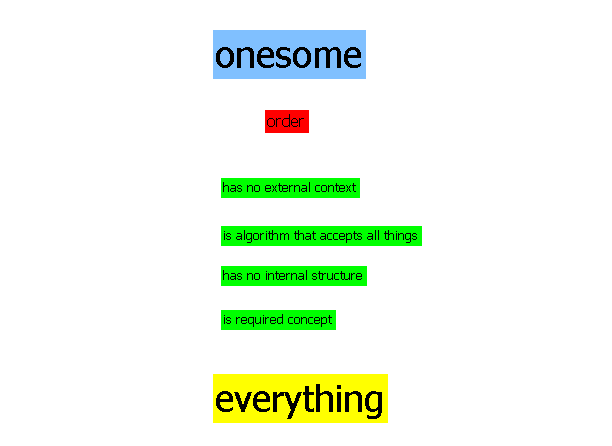
Vienybė yra visko padalinimas į vieną požiūrį.
This structure defines issues of order. The onesome has four representations, which are the properties of everything: +3) no external context, +2) simplest algorithm: accepts all things, +1) no internal structure, +0) required concept. [3/00, Andrius Kulikauskas]

The onesome is the structure that arises when God takes up the question: How does it seem to me? God finds himself at the center. All is defined with regard to him. There is no way to define him. Whether he exists, or does not exist, does not matter, because he is the one who defines what they mean. With regard to him, they are all the same, and they all apply equally. In the mind of God, all things are true, he takes them literally. His state is that of contradiction in mathematics, where all statements are true, and which is prior to mathematics. I speak of "mind" and "state", but again, these are simply references to the onesome, or rather, to the everything, the structure of God.
PropertyOfEverything
- is System
- is explicit
- expresses God's not being (or not) as a Scope
- Vienybė - viskas rieda į vieną tašką - į esmę.
Transcendentals The transcendentals (Latin: transcendentalia) are the properties of being. In typical accounts being is said to be One, Good and True (unum, bonum, verum). ... However, it is in Aristotle that we first see the term transcendentals used. They were so called as they transcended (ὑπερβαίνειν huperbainein) each of his ten categories. Aristotle discusses only unity ("One") explicitly because it is the only transcendental intrinsically related to being, whereas truth and goodness relate to rational creatures.
2018.03.23 A: Kaip vienybė ir jos atvaizdai išreiškia vieningumą?
D: Vieningumas yra mano esmė, mano savybių pagrindas, jų pavidalas, kaip ir viskas yra mano sandara. Vienybės atvaizdų vieningumas yra tas pats viskas, neturintis aplinkos, juk į šią savybę įeina visos kitos visko savybės, užtat tai ir yra viskas, tai yra visko bruožas, užtat ir žinojimas visko yra žinojimas kodėl, būtent visų ryšių su visakuo. O tai yra esmė ir vieningumas, tad viskas išsako jo pavidalą, kaip ir aš, Dievas, išsakau jo dvasią, būtis išsako jo atvaizdus, ir įsitraukimas - dalyvavimas išsako jo esmę, tad trejybė ir yra pagrindas išvedimo ir pagrindas suvedimo.